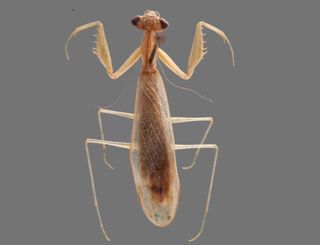
A new praying mantis has been identified, and like Supreme Court Justice Ruth Bader Ginsburg, it has a fondness for prominent neckwear.
The new leaf-dwelling species was discovered in the wilds of Madagascar and named Ilomantis ginsburgae, after Supreme Court Associate Justice Ruth Bader Ginsburg. I. ginsburgae is the first species to be defined and classified based on its female genitalia. Historically, biologists relied on male genitalia to classify and identify species.
"This species description of Ilomantis ginsburgae is novel since it relied heavily on the features of the female genitalia," lead author Sydney Brannoch, a Case Western Reserve University doctoral candidate, said in a statement. "As a feminist biologist, I often questioned why female specimens weren't used to diagnose most species. This research establishes the validity of using female specimens in the classification of praying mantises." [Gallery: Out-of-This-World Images of Insects]
Leaf-dweller
The creature in question was first discovered in Madagascar in 1967, but the specimen has been housed at the French National Museum of Natural History in Paris ever since. Only recently was it closely studied and identified. Like other praying mantises,I. ginsburgae has a green flattened body, huge bug eyes and veiny wings that resemble leaves. Like other mantises, the newly designated species has prominent neck plates that somewhat resemble the frilly collars, called jabots, that Justice Ginsburg is so fond of wearing.
While identifying a species using the female as a prototype may be a nod toward gender equality, it also has practical uses, the researchers say.
"Developing new characteristics, especially from female specimens, helps us not only test the validity of species, but makes identification much easier," said study co-author Gavin Svenson, curator of invertebrate zoology at the Cleveland Museum of Natural History. "Many praying mantis species have males and females that look very different. If a person finds one sex, they may only be able to identify the specimen if their specimen's sex matches what is known from previous research. Our work reduces this impediment by characterizing both sexes for praying mantis species."
The new species is described in the May issue of the journal Insect Systematics & Evolution.
Sign up for the Live Science daily newsletter now
Get the world’s most fascinating discoveries delivered straight to your inbox.
Original article on Live Science.

Tia is the managing editor and was previously a senior writer for Live Science. Her work has appeared in Scientific American, Wired.com and other outlets. She holds a master's degree in bioengineering from the University of Washington, a graduate certificate in science writing from UC Santa Cruz and a bachelor's degree in mechanical engineering from the University of Texas at Austin. Tia was part of a team at the Milwaukee Journal Sentinel that published the Empty Cradles series on preterm births, which won multiple awards, including the 2012 Casey Medal for Meritorious Journalism.
Most Popular

